mirror CHEVROLET PRIZM 1998 3.G Owners Manual
[x] Cancel search | Manufacturer: CHEVROLET, Model Year: 1998, Model line: PRIZM, Model: CHEVROLET PRIZM 1998 3.GPages: 364, PDF Size: 18.79 MB
Page 79 of 364
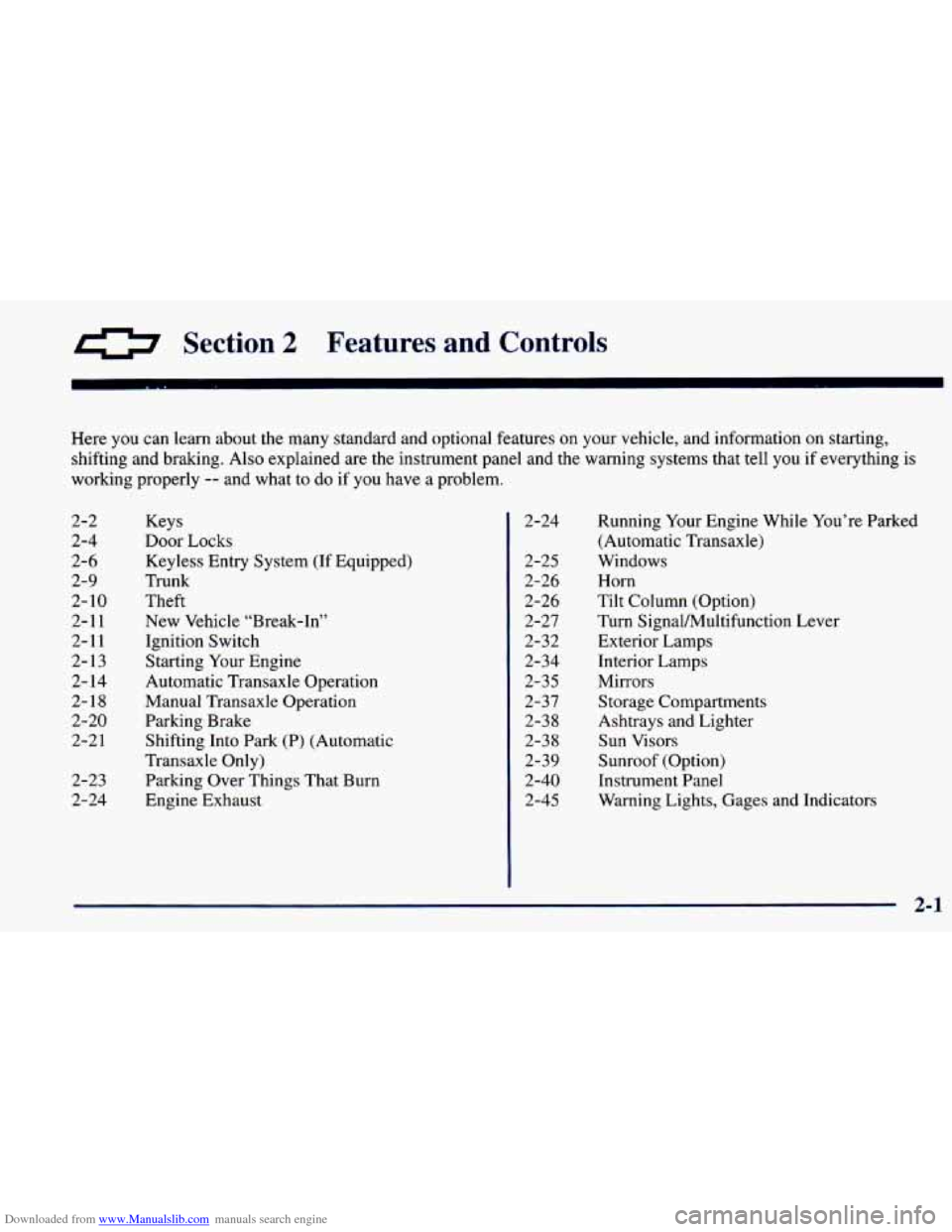
Downloaded from www.Manualslib.com manuals search engine a Section 2 Features and Controls
Here you can learn about the many standard and optional features on your vehicle, and information on starting,
shifting and braking. Also explained are the instrument panel and the warning systems that tell
you if everything is
working properly -- and what to do if you have a problem.
2-2 2-4
2-6
2-9
2-10 2-1
1
2-1 1
2-13 2- 14
2-18
2-20
2-2 1
2-23
2-24 Keys
Door Locks
Keyless Entry System (If Equipped)
Trunk
Theft
New Vehicle “Break-In”
Ignition Switch
Starting Your Engine
Automatic Transaxle Operation
Manual Transaxle Operation
Parking Brake
Shifting Into Park (P) (Automatic
Transaxle Only) Parking Over Things That Burn
Engine Exhaust 2-24
2-25
2-26
2-26
2-27
2-32
2-34
2-3
5
2-37
2-38
2-3
8
2-39
2-40
2-45 Running
Your Engine While You’re Parked
(Automatic Transaxle)
Windows
Horn
Tilt Column (Option)
Turn Signalhlultifunction Lever
Exterior Lamps
Interior Lamps
Mirrors Storage Compartments
Ashtrays and Lighter
Sun Visors
Sunroof (Option)
Instrument Panel
Warning Lights, Gages and Indicators
2-1
Page 113 of 364
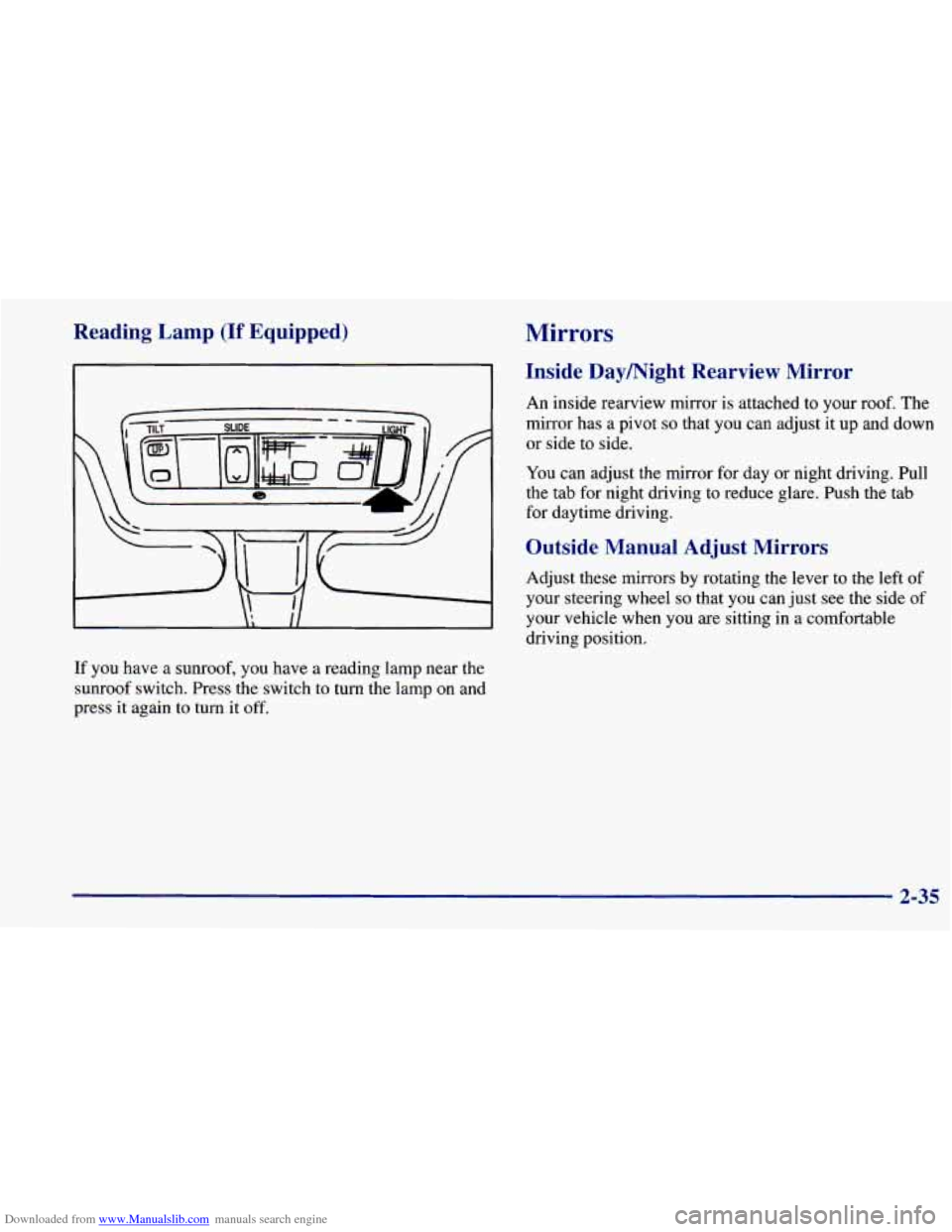
Downloaded from www.Manualslib.com manuals search engine Reading Lamp (If Equipped)
If you have a sunroof, you have a reading lamp near the
sunroof switch. Press the switch to
turn the lamp on and
press it again to
turn it off.
Mirrors
Inside Daymight Rearview Mirror
An inside rearview mirror is attached to your roof. The
mirror has a pivot
so that you can adjust it up and down
or side to side.
You can adjust the mirror for day or night driving. Pull
the tab for night driving to reduce glare. Push the tab
for daytime driving.
Outside Manual Adjust Mirrors
Adjust these mirrors by rotating the lever to the left of
your steering wheel so that you can just see the side of
your vehicle when you are sitting in a comfortable
driving position.
2-35
Page 114 of 364
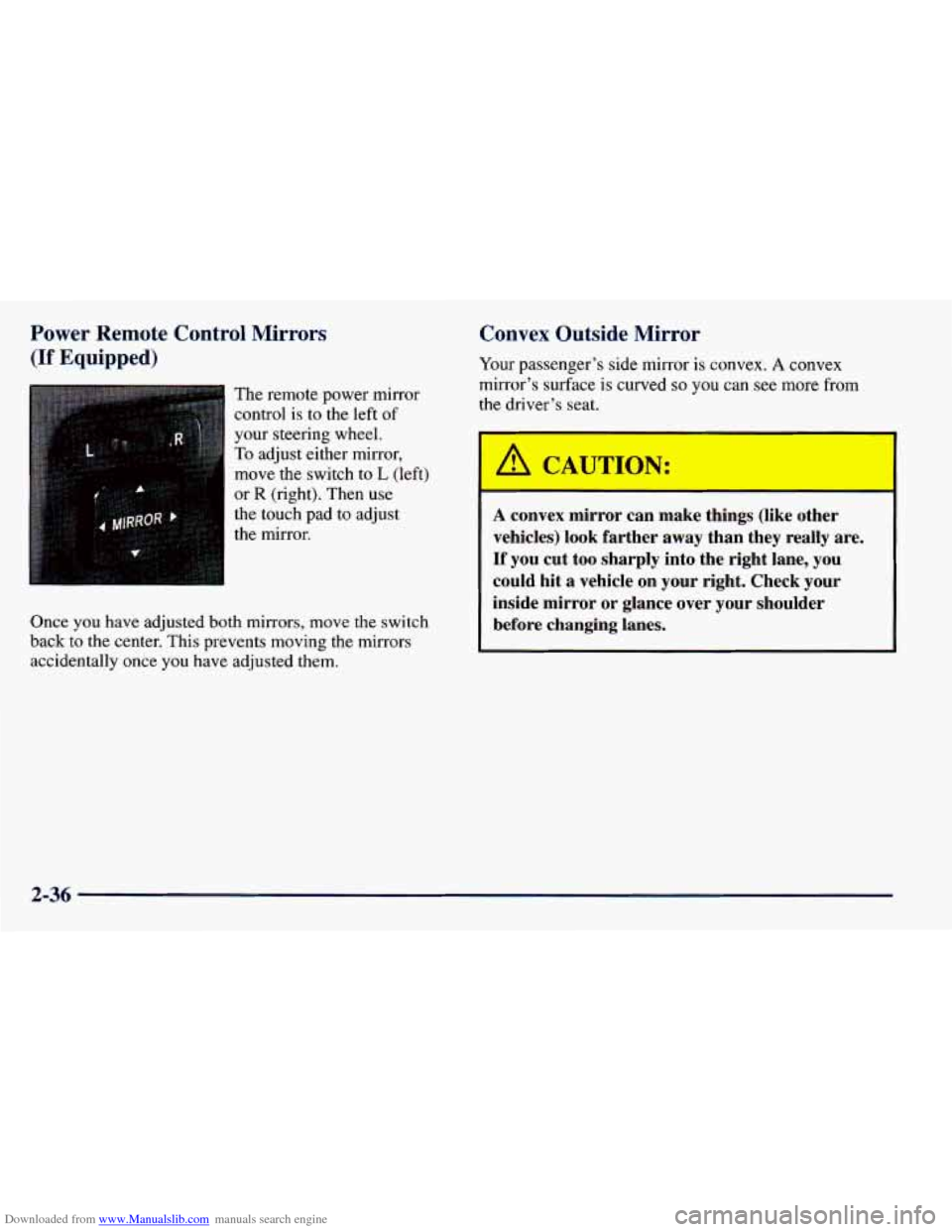
Downloaded from www.Manualslib.com manuals search engine Power Remote C
(If Equipped)
The remote power mirror
control is to the left of
your steering wheel.
To adjust either mirror,
move the switch to
L (left)
or R (right). Then use
the touch pad to adjust
the mirror.
Once you have adjusted both mirrors, move
the switch
back to the center. This prevents moving
the mirrors
accidentally once
you have adjusted them.
Convex Outside Mirror
Your passenger’s side mirror is convex. A convex
mirror’s surface
is curved so you can see more from
the driver’s seat.
A convex mirror can make things (like other
vehicles) look farther away than they really are.
If you cut too sharply into the right lane, you
could hit a vehicle
on your right. Check your
inside mirror or glance over your shoulder
before changing lanes.
2-36
Page 116 of 364
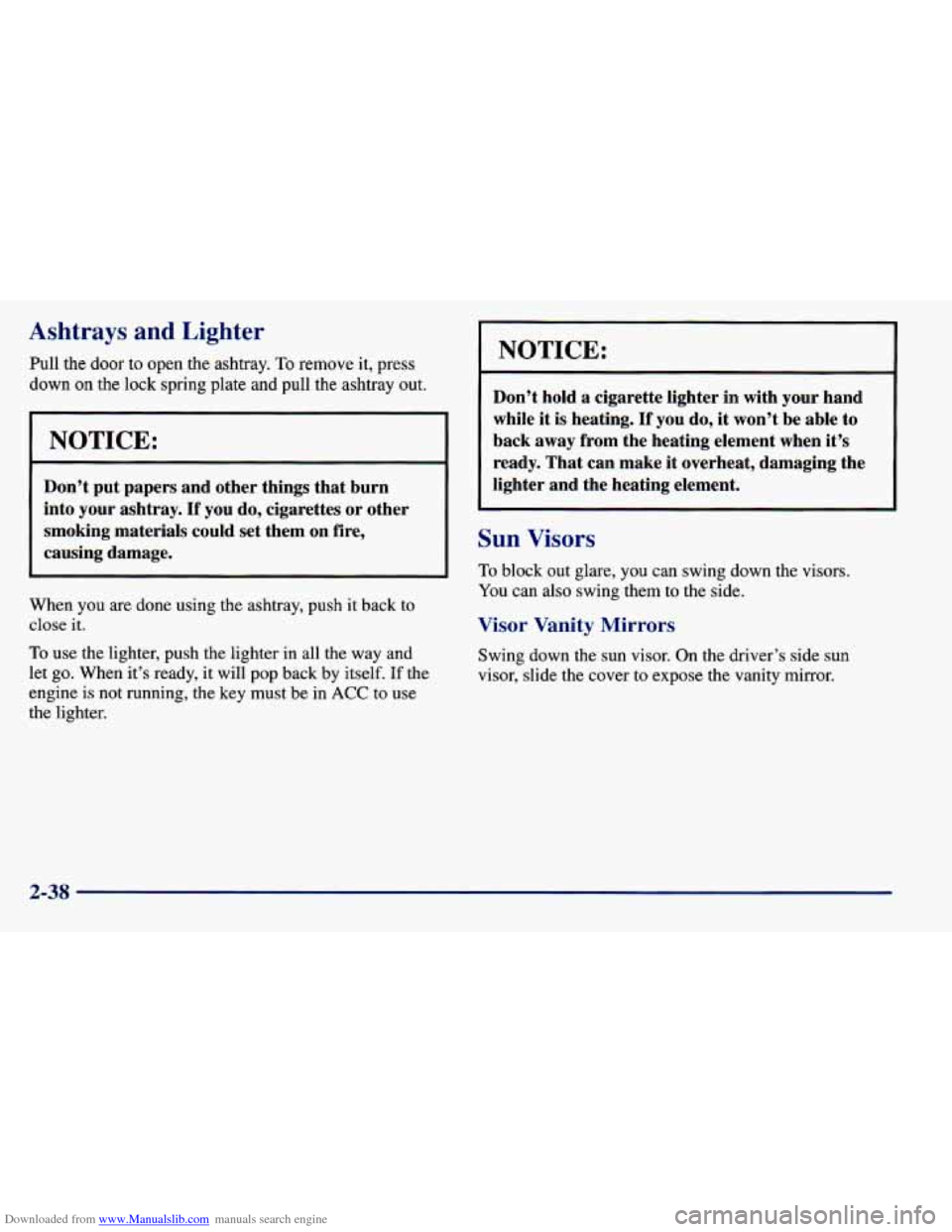
Downloaded from www.Manualslib.com manuals search engine Ashtrays and Lighter
Pull the door to open the ashtray. To remove it, press
down
on the lock spring plate and pull the ashtray out.
NOTICE:
Don’t put papers and other things that burn
into your ashtray.
If you do, cigarettes or other
smoking materials could set them
on fire,
causing damage.
When you are done using the ashtray, push it back to
close
it.
To use the lighter, push the lighter in all the way and
let
go. When it’s ready, it will pop back by itself. If the
engine
is not running, the key must be in ACC to use
the lighter.
NOTICE:
Don’t hold a cigarette lighter in with your hand
while it is heating.
If you do, it won’t be able to
back away from the heating element when it’s
ready. That can make it overheat, damaging the
lighter and the heating element.
Sun Visors
To block out glare, you can swing down the visors.
You can also swing them to the side.
Visor Vanity Mirrors
Swing down the sun visor. On the driver’s side sun
visor, slide the cover to expose the vanity mirror.
2-38
Page 119 of 364
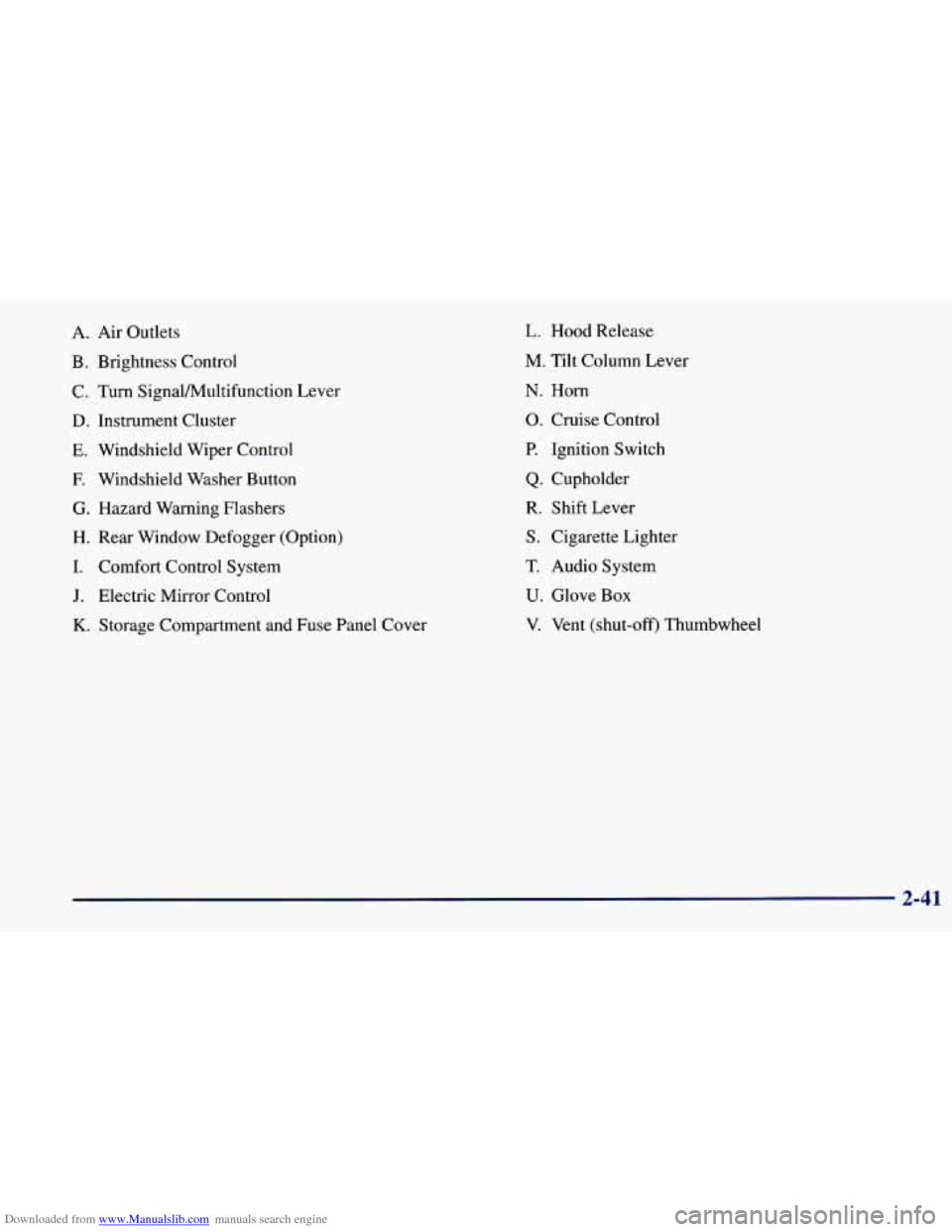
Downloaded from www.Manualslib.com manuals search engine A. Air Outlets
B. Brightness Control
C.
Turn SignalMultifunction Lever
D. Instrument Cluster
E. Windshield Wiper Control
E Windshield Washer Button
G. Hazard Warning Flashers
H. Rear Window Defogger (Option)
I. Comfort Control System
J. Electric Mirror Control
K. Storage Compartment and Fuse Panel Cover L.
Hood Release
M. Tilt Column Lever
N. Horn
0. Cruise Control
P. Ignition Switch
Q. Cupholder
R. Shift Lever
S. Cigarette Lighter
T. Audio System
U. Glove Box
V. Vent (shut-off) Thumbwheel
2-41
Page 165 of 364
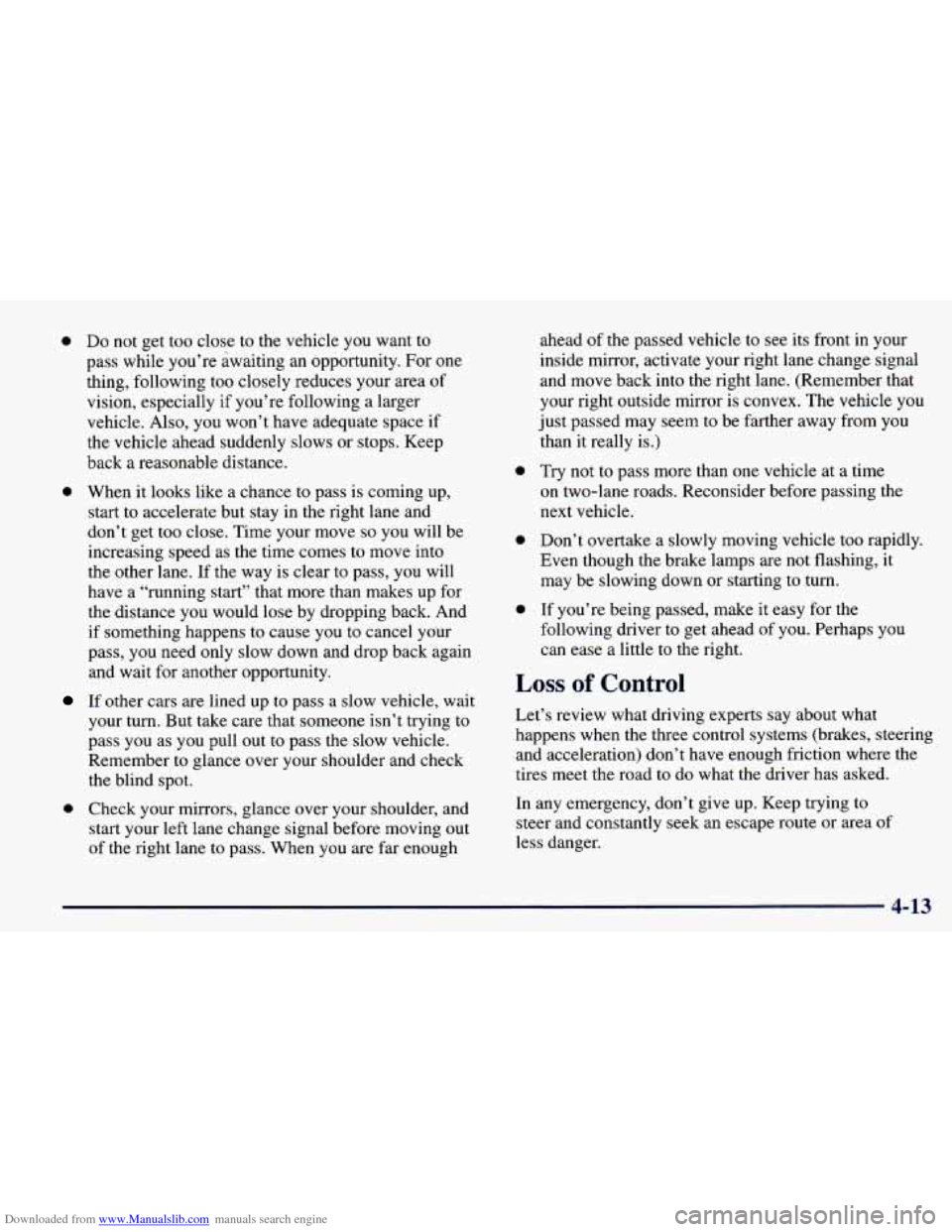
Downloaded from www.Manualslib.com manuals search engine 0 Do not get too close to the vehicle you want to
pass while you’re awaiting an opportunity. For one
thing, following too closely reduces your area of
vision, especially if you’re following a larger
vehicle. Also, you won’t have adequate space if
the vehicle ahead suddenly slows or stops. Keep
back
a reasonable distance.
0 When it looks like a chance to pass is coming up,
start to accelerate but stay in the right lane and
don’t get too close. Time your move
so you will be
increasing speed as the time comes to move into
the other lane.
If the way is clear to pass, you will
have a “running start” that more than makes up for
the distance you would lose by dropping back. And
if something happens
to cause you to cancel your
pass, you need only slow down and
drop back again
and wait for another opportunity.
If other cars are lined up to pass a slow vehicle, wait
your turn. But take care that someone isn’t trying to
pass you as you pull out to pass the slow vehicle.
Remember to glance over your shoulder and check
the blind spot.
0 Check your mirrors, glance over your shoulder, and
start your left lane change signal before moving out
of the right lane to pass. When you are far enough
0
0
0
ahead of the passed vehicle to see its front in your
inside mirror, activate your right lane change signal
and move back into the right lane. (Remember that
your right outside mirror is convex. The vehicle
you
just passed may seem to be farther away from you
than it really is.)
Try not to pass more than one vehicle at a time
on two-lane roads. Reconsider before passing the
next vehicle.
Don’t overtake a slowly moving vehicle too rapidly.
Even though the brake lamps are not flashing, it
may be slowing down
or starting to turn.
If you’re being passed, make it easy for the
following driver to get ahead of
you. Perhaps you
can ease a little to the right.
Loss of Control
Let’s review what driving experts say about what
happens when the three control systems (brakes, steering and acceleration) don’t have enough friction where the
tires meet the road to do what the driver has asked.
In any emergency, don’t give up. Keep trying to
steer and constantly seek an escape route or area of
less danger.
4-13
Page 166 of 364
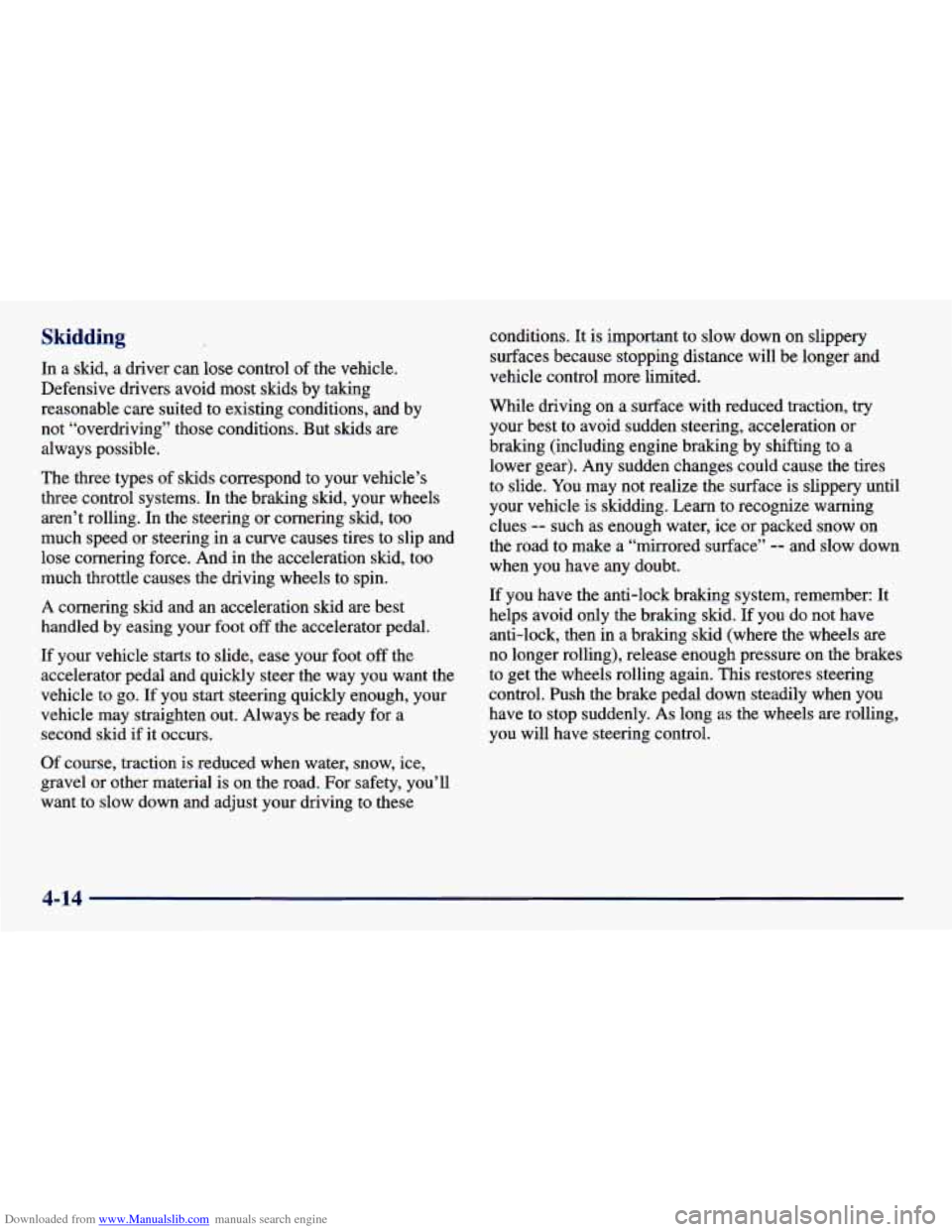
Downloaded from www.Manualslib.com manuals search engine Skidding
In a skid, a driver can lose control of the vehicle.
Defensive drivers avoid most skids by taking
reasonable care suited to existing conditions, and by
not “overdriving” those conditions. But skids are
always possible.
The three types of skids correspond to your vehicle’s
three control systems. In the braking skid, your wheels
aren’t rolling. In the steering or cornering skid, too
much speed or steering in a curve causes tires to slip and
lose cornering force. And in the acceleration skid, too
much throttle causes the driving wheels to spin.
A cornering skid and an acceleration skid are best
handled
by easing your foot off the accelerator pedal.
If your vehicle starts to slide, ease your foot off the
accelerator pedal and quickly steer the way you want the
vehicle
to go. If you start steering quickly enough, your
vehicle may straighten out. Always be ready for a
second skid
if it occurs.
Of course, traction is reduced when water, snow, ice,
gravel or other material is on the road. For safety, you’ll
want to slow down and adjust your driving to these conditions.
It is important to slow down on slippery
surfaces because stopping distance
will be longer and
vehicle control more limited.
While driving on a surface with reduced traction,
try
your best to avoid sudden steering, acceleration or
braking (including engine braking by shifting to a
lower gear). Any sudden changes could cause the tires
to slide.
You may not realize the surface is slippery until
your vehicle is skidding. Learn to recognize warning
clues
-- such as enough water, ice or packed snow on
the road to make a “mirrored surface”
-- and slow down
when you have any doubt.
If you have the anti-lock braking system, remember: It
helps avoid only the braking skid. If
you do not have
anti-lock, then in a braking skid (where the wheels are
no longer rolling), release enough pressure on the brakes
to get the wheels rolling again. This restores steering
control.
Push the brake pedal down steadily when you
have to stop suddenly.
As long as the wheels are rolling,
you will have steering control.
Page 167 of 364
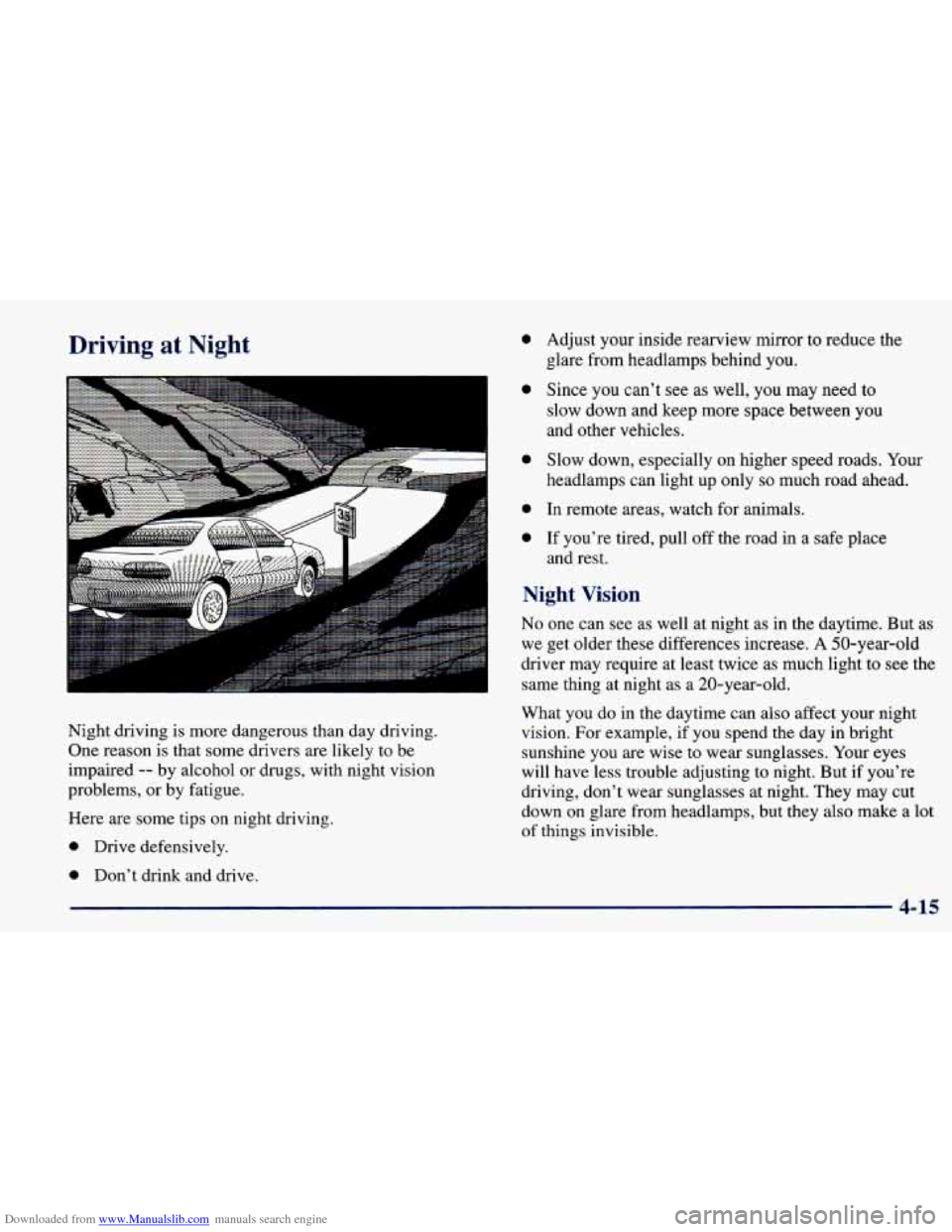
Downloaded from www.Manualslib.com manuals search engine Driving at Night
5--
. . . . . . . . . . .. . . .
Night driving is more dangerous than day driving.
One reason is that some drivers are likely to be
impaired
-- by alcohol or drugs, with night vision
problems, or by fatigue.
Here are some tips on night driving.
0 Drive defensively.
0 Don’t drink and drive.
0
0
0
0
0
Adjust your inside rearview mirror to reduce the
glare from headlamps behind you.
Since you can’t
see as well, you may need to
slow down and keep more space between you
and other vehicles.
Slow down, especially
on higher speed roads. Your
headlamps can light up only
so much road ahead.
In remote areas, watch for animals.
If you’re tired, pull
off the road in a safe place
and rest.
Night Vision
No one can see as well at night as in the daytime. But as
we get older these differences increase. A 50-year-old
driver may require at least twice as much light to
see the
same thing at night as
a 20-year-old.
What you do in the daytime can also affect your night
vision. For example, if
you spend the day in bright
sunshine you are wise to wear sunglasses. Your eyes
will have less trouble adjusting to night. But if you’re
driving, don’t wear sunglasses at night. They may cut
down on glare from headlamps, but they also make a lot
of things invisible.
4-15
Page 172 of 364
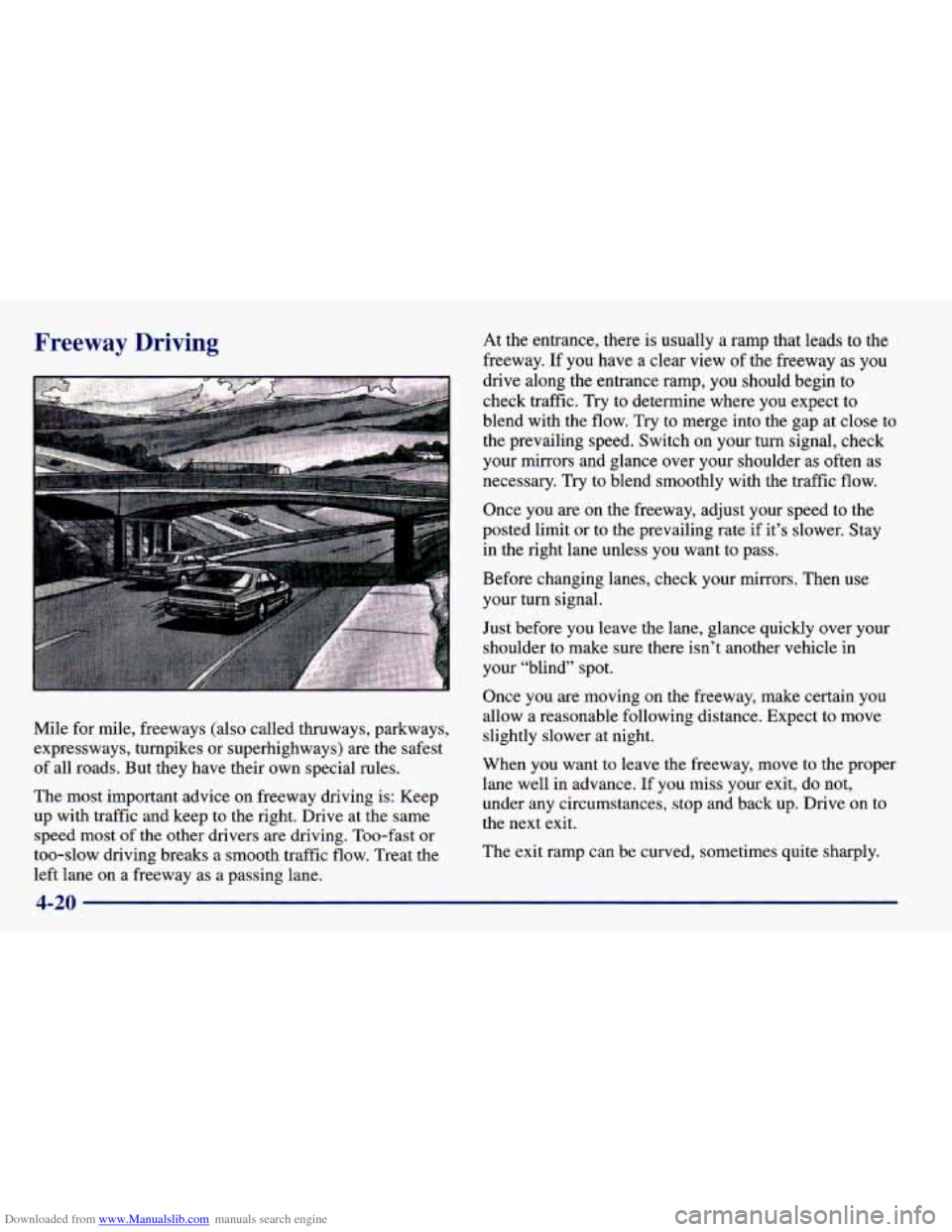
Downloaded from www.Manualslib.com manuals search engine Freeway Driving
Mile for mile, freeways (also called thruways, parkways,
expressways, turnpikes or superhighways) are the safest
of all roads. But they have their own special rules.
The most important advice on freeway driving is: Keep
up with traffic and keep to the right. Drive at the same
speed most of the other drivers are driving. Too-fast or
too-slow driving breaks a smooth traffic flow. Treat the
left lane on
a freeway as a passing lane. At the
entrance, there
is usually a ramp that leads to the
freeway.
If you have a clear view of the freeway as you
drive along the entrance
ramp, you should begin to
check traffic. Try to determine where
you expect to
blend with the flow. Try to merge into the gap at close to
the prevailing speed. Switch
on your turn signal, check
your mirrors and glance over your shoulder
as often as
necessary.
Try to blend smoothly with the traffic flow.
Once you are on the freeway, adjust your speed to the
posted limit or to the prevailing rate if it’s slower. Stay
in the right lane unless you want to pass.
Before changing lanes, check your mirrors. Then use
your turn signal.
Just before you leave the lane, glance quickly over your
shoulder to make sure there isn’t another vehicle in
your “blind” spot.
Once you are moving
on the freeway, make certain you
allow a reasonable following distance. Expect to move
slightly slower at night.
When you want to leave the freeway, rkiovk to the proper
lane well in advance. If you miss your exit, do not,
under any circumstances, stop and back up. Drive on to
the next exit.
The exit ramp can be curved, sometimes quite sharply.
4-20
Page 174 of 364
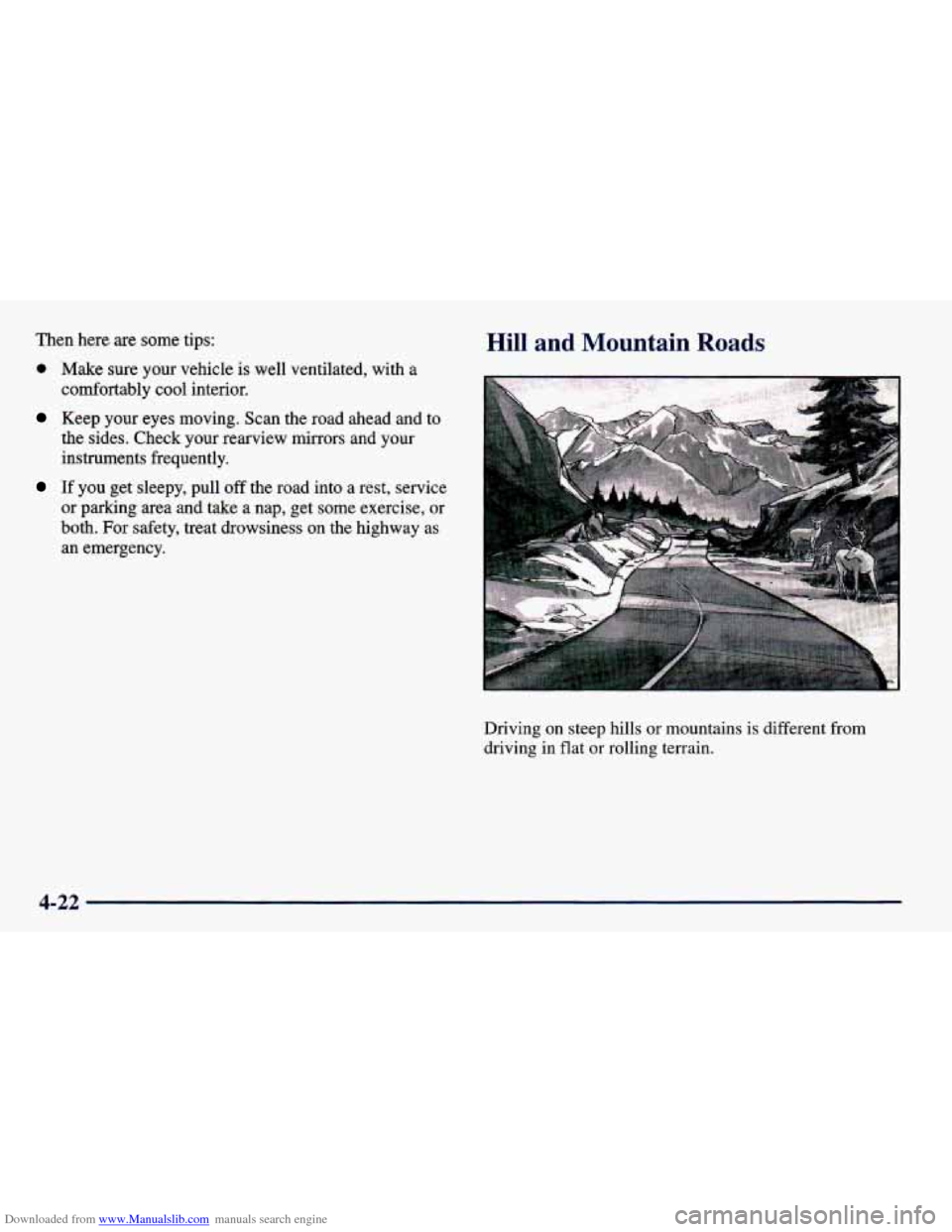
Downloaded from www.Manualslib.com manuals search engine Then here are some tips:
0 Make sure your vehicle is well ventilated, with a
comfortably cool interior.
Keep your eyes moving. Scan the road ahead and to
the sides. Check your rearview mirrors and your
instruments frequently.
If you get sleepy, pull off the road into a rest, service
or parking area and take a nap, get some exercise, or
both. For safety, treat drowsiness on the highway as
an emergency.
Hill and Mountain Roads
Driving on steep hills or mountains is different from
driving in
flat or rolling terrain.
4-22